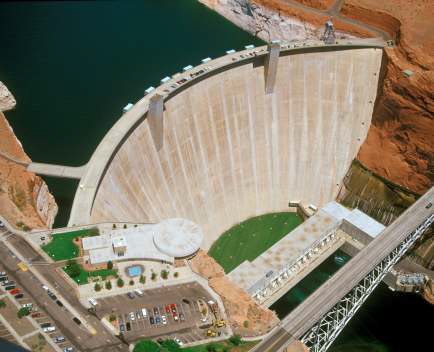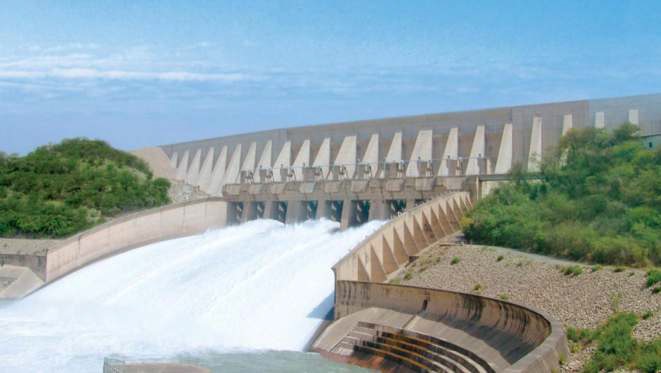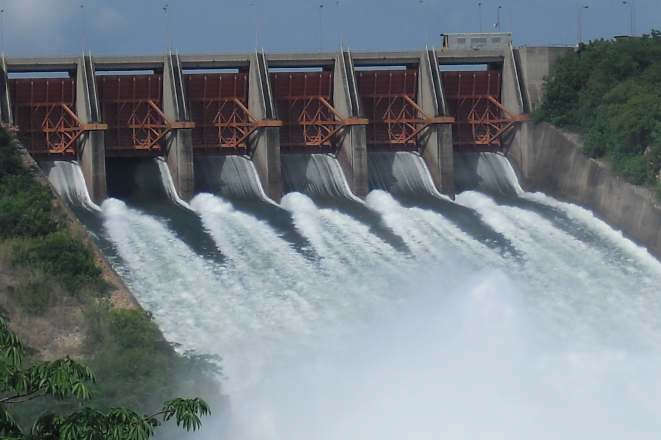A dam is a barrier that stops or restricts the flow of water or underground streams. Reservoirs created by dams not only suppress floods but also provide water for activities such as irrigation, human consumption, industrial use, aquaculture, and navigability. Hydropower is often used in conjunction with dams to generate electricity. A dam can also be used to collect water or for storage of water which can be evenly distributed between locations. Dams generally serve the primary purpose of retaining water, while other structures such as floodgates or levees (also known as dikes) are used to manage or prevent water flow into specific land regions.
ADVANTAGES:
- Once a dam is constructed, electricity can be produced at a constant rate.
- If electricity is not needed, the sluice gates can be shut, stopping electricity generation. The water can be saved for use another time when electricity demand is high.
- Dams are designed to last many decades and so can contribute to the generation of electricity for many years/decades.
- The lake that forms behind the dam can be used for water sports and leisure/pleasure activities. Often large dams become tourist attractions in their own right.
- The lake’s water can be used for irrigation purposes.
- The build up of water in the lake means that energy can be stored until needed, when the water is released to produce electricity.
- When in use, electricity produced by dam systems do not produce greenhouse gases. They do not pollute the atmosphere.
The purpose of dams
Demand for water is steadily increasing throughout the world. There is no life on earth without water, our most important resource apart from air and land. During the past three centuries, the amount of water withdrawn from freshwater resources has increased by a factor of 35, world population by a factor of 8. With the present world population of 5.6 billion still growing at a rate of about 90 million per year, and with their legitimate expectations of higher standards of living, global water demand is expected to rise by a further 2-3 percent annually in the decades ahead.
But freshwater resources are limited and unevenly distributed. In the high-consumption countries with rich resources and a highly developed technical infrastructure, the many ways of conserving, recycling and re-using water may more or less suffice to curb further growth in supply. In many other regions, however, water availability is critical to any further development above the present unsatisfactorily low level, and even to the mere survival of existing communities or to meet the continuously growing demand originating from the rapid increase of their population. In these regions man cannot forego the contribution to be made by dams and reservoirs to the harnessing of water resources.
Seasonal variations and climatic irregularities in flow impede the efficient use of river runoff, with flooding and drought causing problems of catastrophic proportions. For almost 5 000 years dams have served to ensure an adequate supply of water by storing water in times of surplus and releasing it in times of scarcity, thus also preventing or mitigating floods
It serves for;
- Irrigation
- Hydropower
- Water supply for Domestic and Industrial use
- Inland navigation
- Flood control

Adopting strategy for Water Quality maintenance issues
While not every dam causes huge problems, cumulatively the world’s large dams have replumbed rivers in a massive experiment that has left the planet’s freshwaters in far worse shape than any other major ecosystem type, including tropical rainforests. In response, dam-affected communities in many parts of the world are working to resolve the legacies of poorly planned dams.
Large dams have created a sad legacy of social injustices and environmental degradation that often outweighs the benefits they bring. The parties involved in approving, financing, designing and building dams should be held responsible for solving problems created by dams, but in the majority of cases, responsible parties have taken few or no steps to resolve outstanding problems, leaving affected people to fend for themselves.
This special issue of World Rivers Review reports on a few key reparations case studies, and describes actions that people around the globe are taking to address the legacy of large dams.
Decomissioning of dams has primarily taken place in the US and Europe, although the people of the Mun River in Thailand have also made significant strides in having dam gates opened to restore fisheries.
The trend is likely to go worldwide, however, as climate change makes the safety of dams and the high cost of retrofitting them a serious argument for decommissioning.
The damming of great rivers is among the most dramatic, deliberate impacts that humans have on their natural environment. Nothing alters a river as totally as a dam. A dam is an attempt to bring a river under control, to regulate its seasonal pattern of floods and low flows.
A dam traps sediments and nutrients, alters the river’s temperature and chemistry, and upsets the geological processes of erosion and deposition through which the river sculpts the surrounding land. Such changes can throw an entire watershed out of ecological balance.
An estimated 50,000 large dams now block most big river systems. Dams now hold back 15% of the world’s annual freshwater runoff.
If we want to sustain the world’s biodiversity and riverine goods and services, then we need to replace large dam building with alternate solutions.
Many water quality issues are associated with the collection, storage and reticulation of water. Storing water from underground sources in dams can result in a rapid deterioration of water quality due to evaporation and the associated concentration of dissolved salts. Unfenced catchment dams can be easily fouled by stock wading and defecating in the water. Poorly vegetated catchment areas can result in significant quantities of organic matter, manure, fertiliser and soil entering the water supplies.
The following strategies can help to maintain good water quality:
- Store saline water in tanks rather than in dams
- Fence off dams and reticulate water into troughs for stock
- Protect dam catchments with good ground cover and maintain a grassed filter strip at the dam inlet
- Clean troughs regularly
- Establish windbreaks adjacent to dams to reduce evaporation
- Construct sediment traps to protect dams during high risk periods
In short, the four major steps that need to be taken to in order to lessen the detrimental impacts of dams are as follows:
- Disassemble old, outdated dams
- Make existing hydroelectric dams more efficient
- Research on alternative sources of energy and efficient usage of water in agriculture and alternatives to new proposed dams
- Make sure new proposed dams are built at a site that result in the least amount of environmental and societal damage.

Use of Check Dams
In addition to controlling gully erosion, check dams also serve to slow the movement of water, allowing increased percolation into the soil. Just above a check dam is a good place to put in a percolation structure. Silt that builds up behind the dam creates good farmland, which can be planted after the rains while it retains moisture. If the purpose of a check dam is to create good land for planting after the rains, a structure called a nala bund can be used. The earthen bund will lead to flooding of the upstream area and retention of moisture and silt. The small weir allows for overflow into a narrow channel over gently sloping stone pitching. The stone section is built to hold back the silt, creating a good area for planting.
Factors that should be considered when building dams
Dams should be situated at a site which has the least environmental impacts, where, for example, there is no danger of an endangered species dying out. The dimensions of the dam and reservoirs should also be taken into account. Dams should minimize surface area and maximize depth so as to reduce evaporation and the rate of siltation. Thus it is preferable to situate dams in deep gorges that will require little or no flooding of forests, to prevent decay and hence, carbon dioxide and methane production and eutrophication [23]. Simulations should be done by the research group suggested my Mission 2017 or the project developers to project the effects of the dam on the numbers of organisms originally living in the river and also the effects on the people living near the site. The project only approved if it is predicted that the affected individuals will be able to tackle the effect of the dam.
Conclusion
Dams and reservoirs, though effective sources of water and electricity, are immensely detrimental to the environment. To allay concern over the environment, there is proposal to reduce the numbers of dams in the rivers and allow rivers to flow naturally to preserve the environment and biodiversity. At present, it is not possible to eliminate all dams. Still, there must be efforts to take down old, outdated dams and to return as many rivers to their natural state as possible.
Source – vic.gov.au, Icold-cigb, indiawaterportal.org, mit.edu/mission2017


